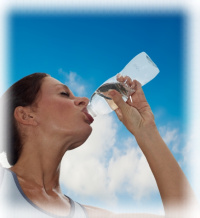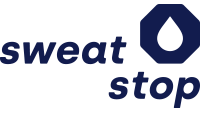Perspiration Guide - Prevention
 The first action that needs to be implemented against excessive sweating is prevention. Before taking hold of treatment methods, you should consider the measures listed below.
The first action that needs to be implemented against excessive sweating is prevention. Before taking hold of treatment methods, you should consider the measures listed below. Taking into account these measures can yield good results for most persons concerned; thus the number of situations causing perspiration can be essentially reduced. In particular cases the formation of excessive sweating even can be completely prevented.
Anybody wanting to reduce his perspiration should start off with simple, obvious measures as for instance proper clothes and nutrition just like going in for sports sufficiently. If these actions alone are not sufficient, a combination with an antiperspirant should be tried out. Even when using an antiperspirant it is advantageous to consider these basic rules.
Following advices should therefore be taken into account:
Clothes
Wearing breathable and loose clothes
Basically clothes supporting cutaneous respiration, like for instance cotton, linen or other natural materials should be worn. Synthetic fabric should be renounced, as these are not particularly breathable. Moreover loose clothing should be chosen. Tight clothes promote the formation of big pit stains.
Wearing breathable footgear
Footgear should be as breathable as possible. Due to its high breathability, leather should be preferred to synthetics for closed shoes. Special footgear and socks are available in commerce.
Nutrition
Drink a lot
Persons excessively perspiring should drink a lot and also on a regular basis. Sage tee, water or mineral water in combination with apple juice (in the proportion of 3 x water / 1x apple juice) would be optimal. Thus the body is supplied with water for thermoregulation and vital mineral nutrients that are lost due to perspiration.
“Drinking less = sweating less” is a misbelieve! Less water in the human body means that it warms faster, which leads to a quicker initiation of perspiration.
Abstain from spicy food
Flavorful heat is concerned as pain perception from a medical point of view. Substances which generate such a “feeling of heat” (e.g. pepper, cayenne, chili) affect the heat receptors. This releases a chemical heat or pain impulse. As this perception is not hearkening back to an actual temperature rise, spicy food eaten cold can also be perceived “hot”. However, the heat of food is also determined by the temperature. Hence, the hotter spicy food it is served, the hotter it is perceived.
Perspiration restraining aliments amongst others are rice, lemons, or fresh figs.
Abstain from coffee, alcohol, cigarettes, sweets and milk
Regular alcohol consumption and smoking have negative effects on the arteries and on the regulation of perspiration. Alcohol consumption and smoking on a regular basis therefore promote perspiration. Also one should dispense with coffee and sweets. A possible coherence between sweating and the consumption of milk is more and more being discussed. Some persons report about essential reduction of perspiration due to the abandonment of milk products.
Possibly your body reacts with increased perspiration to particular aliments. Observe this and abstain from according aliments.
Reduce overweight
Overweight persons frequently suffer from increased perspiration. Negative effects such as a weak circulation and an extra strain through the increased weight add up in these cases.
Consume tees restraining perspiration
-
Drink sage tee
Sage tee lessons perspiration. Therefore a regular consumption (about 3 times a day) is to be recommended. To do so, pour boiling water on fine cut sage leaves (1-2 tea spoons) in a cup. Brew for 10 minutes and carefully filter it. Before drinking, the tee should cool down a little, as otherwise it promotes perspiration. Besides the lessening of perspiration, sage tee has other positive effects: it acts disinfectant, anti-inflammatory and anticonvulsant.
- Drink walnut-leave tee
Walnut leaves help reducing perspiration. A brew can easily be prepared: Add two or three tea spoons of dried leaves per cup of water (100 ml or 3.51 Fl.OZ.) and bring it to a boil. Let it simmer for about 15 minutes and after that pour it through a tea strainer. Use the brew as a compress or as a partial bath for the affected part of the body e.g feet. Tannins are responsible for the effect. They also bring about an anti-inflammatory effect. Unfortunately there are no preparations available for such uses. Consequently, those who want to try this household remedy have to get the leaves by themselves.
Source: Health magazine “Apotheken Umschau”
Source: Health magazine “Apotheken Umschau”
Oak tree bark – bath
Soak 10-15 soup spoons of oak tree bark in 1,5 liter (about 50 Fl.oz.) for about 10 hours. Afterwards boil up for 2-3 minutes and filter it. Thereafter take a bath in it.
Reduce stress
Stressful situations bring about perspiration. This type of perspiring does not really have anything to do with the body’s need for cooling. It is of psychic nature. As a result, the own skill to reduce stress constructively needs to be enhanced.
Generally one needs to become aware ones of fears and after that needs to free from them. Once one “came to terms” with ones psyche, “cold sweat” is finally a thing of the past.
To reduce stress, going in for sports and relaxation methods like for instance autogenic training, yoga or tai chi are supportive. These techniques help to reduce psychical and physical tension.
Sports & Sauna
Going in for sports on a regular basis prevents unexpected sweating. Principally it does not matter what kind of exercise is being taken, however it is important that the body works up a sweat. The more the body is sweating, the less it is sweating in undesirable situations. Therefore regularly having a sauna acts supportive.
Kneippism
Kneippism emphasizes traditional, holistic naturopathic treatments. Here natural impulses like temperatures, movement, botanical active ingredients, water and nutrition to which the human has accustomed over the time of evolution, are medically employed. Kneippism can be used preventively but also against existent diseases.
- Wading (hyperhidrosis of feet)
- Treading snow (hyperhidrosis of feet)
- Packing (hyperhidrosis of hands and feet)
 Deutsch
Deutsch
 English
English
 Français
Français
 Spanisch
Spanisch




